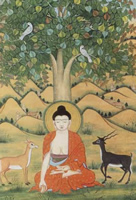 |
Prince Siddhartha Gautama left his home and family and all his possessions behind at the age of 29 to discover the meaning of life. After six years of rigorous discipline and asceticism under the guidance of a number of spiritual teachers, he still hadn’t found what he was seeking, and he went off by himself, broke his fast, and sat under a pipal tree, vowing not to arise until he had finally reached enlightenment.
Over a period of days he faced several temptations, visions of mythic figures that tried to disrupt his resolve. And then on the morning of the eighth day he came to a realisation of what he believed to be the nature of existence. Bodhi Day—usually observed on 8 December or the Sunday immediately preceding—is, according to Mahayana tradition, the date of his enlightenment and his subsequent revelation of the ‘four noble truths’:
| • | Dukkha: All existence is unsatisfactory and filled with suffering. |
| • | Trsna: The root of suffering can be defined as a craving or clinging to the wrong things; searching to find stability in a shifting world is the wrong way. |
| • | Nirvana: It is possible to find an end to suffering. |
| • | The ‘noble eightfold path’ is the way to find the solution to suffering and bring it to an end. |
From that point forward, Siddhartha Gautama was referred to as the Buddha, i.e. the ‘enlightened one’.